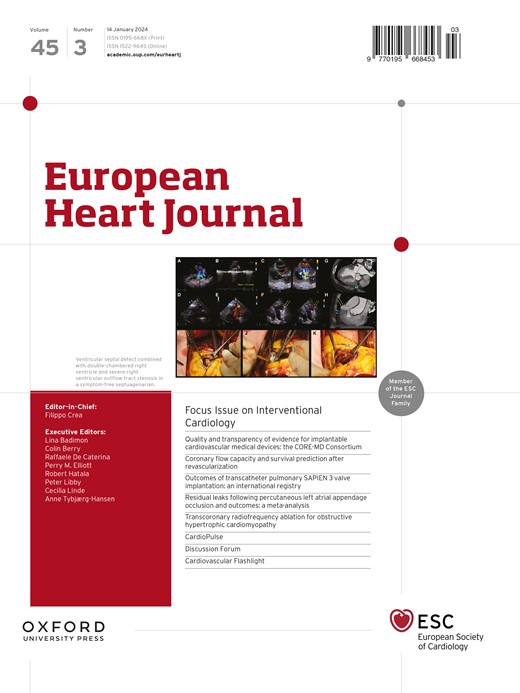Skeletal muscle adiposity, coronary microvascular dysfunction, and adverse cardiovascular outcomes
IF 37.6
1区 医学
Q1 CARDIAC & CARDIOVASCULAR SYSTEMS
引用次数: 0
Abstract
Background and Aims Skeletal muscle (SM) fat infiltration, or intermuscular adipose tissue (IMAT), reflects muscle quality and is associated with inflammation, a key determinant in cardiometabolic disease. Coronary flow reserve (CFR), a marker of coronary microvascular dysfunction (CMD), is independently associated with body mass index (BMI), inflammation and risk of heart failure, myocardial infarction, and death. The relationship between SM quality, CMD, and cardiovascular outcomes is not known. Methods Consecutive patients (n = 669) undergoing evaluation for coronary artery disease with cardiac stress positron emission tomography demonstrating normal perfusion and preserved left ventricular ejection fraction were followed over a median of 6 years for major adverse cardiovascular events (MACEs), including death and hospitalization for myocardial infarction or heart failure. Coronary flow reserve was calculated as stress/rest myocardial blood flow. Subcutaneous adipose tissue (SAT), SM, and IMAT areas (cm2) were obtained from simultaneous positron emission tomography attenuation correction computed tomography using semi-automated segmentation at the 12th thoracic vertebra level. Results Median age was 63 years, 70% were female, and 46% were nonwhite. Nearly half of patients were obese (46%, BMI 30–61 kg/m2), and BMI correlated highly with SAT and IMAT (r = .84 and r = .71, respectively, P < .001) and moderately with SM (r = .52, P < .001). Decreased SM and increased IMAT, but not BMI or SAT, remained independently associated with decreased CFR (adjusted P = .03 and P = .04, respectively). In adjusted analyses, both lower CFR and higher IMAT were associated with increased MACE [hazard ratio 1.78 (95% confidence interval 1.23–2.58) per −1 U CFR and 1.53 (1.30–1.80) per +10 cm2 IMAT, adjusted P = .002 and P < .0001, respectively], while higher SM and SAT were protective [hazard ratio .89 (.81–.97) per +10 cm2 SM and .94 (.91–.98) per +10 cm2 SAT, adjusted P = .01 and .003, respectively]. Every 1% increase in fatty muscle fraction [IMAT/(SM + IMAT)] conferred an independent 2% increased odds of CMD [CFR <2, odds ratio 1.02 (1.01–1.04), adjusted P = .04] and a 7% increased risk of MACE [hazard ratio 1.07 (1.04–1.09), adjusted P < .001]. There was a significant interaction between CFR and IMAT, not BMI, such that patients with both CMD and fatty muscle demonstrated highest MACE risk (adjusted P = .02). Conclusions Increased intermuscular fat is associated with CMD and adverse cardiovascular outcomes independently of BMI and conventional risk factors. The presence of CMD and SM fat infiltration identified a novel at-risk cardiometabolic phenotype.骨骼肌肥胖、冠状动脉微血管功能障碍和不良心血管结局
背景和目的骨骼肌(SM)脂肪浸润或肌间脂肪组织(IMAT)反映肌肉质量并与炎症有关,炎症是心脏代谢疾病的关键决定因素。冠状动脉血流储备(CFR)是冠状动脉微血管功能障碍(CMD)的标志,与身体质量指数(BMI)、炎症、心衰、心肌梗死和死亡风险独立相关。SM质量、CMD和心血管结局之间的关系尚不清楚。方法连续接受冠状动脉疾病评估的患者(n = 669),心脏应激正电子发射断层扫描显示灌注正常,左心室射血分数保留,随访时间中位数为6年,主要不良心血管事件(mace),包括死亡和因心肌梗死或心力衰竭住院。冠状动脉血流储备计算为应激/休息心肌血流。皮下脂肪组织(SAT), SM和IMAT区域(cm2)通过同时使用半自动分割的正电子发射断层扫描衰减校正计算机断层扫描在第12胸椎水平获得。结果中位年龄为63岁,女性占70%,非白人占46%。近一半的患者肥胖(46%,BMI 30-61 kg/m2), BMI与SAT、IMAT高度相关(r = 0.84、r = 0.71), P <;.001),中度伴SM (r = .52, P <;措施)。SM降低和IMAT升高,而BMI或SAT不与CFR降低独立相关(分别校正P = 0.03和P = 0.04)。在校正分析中,较低的CFR和较高的IMAT均与MACE增加相关[风险比为1.78(95%可信区间1.23-2.58)/−1 U CFR和1.53 (1.30-1.80)/ +10 cm2 IMAT,校正P = 0.002和P &;lt;较高的SM和SAT具有保护作用[风险比分别为0.89 (0.81 - 0.97)/ +10 cm2和0.94 (0.91 - 0.98)/ +10 cm2,调整后P分别为0.01和0.003]。脂肪肌分数[IMAT/(SM + IMAT)]每增加1%,CMD [CFR <2,优势比1.02(1.01-1.04),校正P = .04]的独立风险增加2%,MACE[危险比1.07(1.04-1.09),校正P &;lt;措施)。CFR和IMAT之间存在显著的相互作用,而不是BMI,因此同时患有CMD和脂肪肌肉的患者表现出最高的MACE风险(校正P = 0.02)。结论肌间脂肪增加与CMD和心血管不良结局相关,独立于BMI和常规危险因素。CMD和SM脂肪浸润的存在确定了一种新的高危心脏代谢表型。
本文章由计算机程序翻译,如有差异,请以英文原文为准。
求助全文
约1分钟内获得全文
求助全文
来源期刊

European Heart Journal
医学-心血管系统
CiteScore
39.30
自引率
6.90%
发文量
3942
审稿时长
1 months
期刊介绍:
The European Heart Journal is a renowned international journal that focuses on cardiovascular medicine. It is published weekly and is the official journal of the European Society of Cardiology. This peer-reviewed journal is committed to publishing high-quality clinical and scientific material pertaining to all aspects of cardiovascular medicine. It covers a diverse range of topics including research findings, technical evaluations, and reviews. Moreover, the journal serves as a platform for the exchange of information and discussions on various aspects of cardiovascular medicine, including educational matters.
In addition to original papers on cardiovascular medicine and surgery, the European Heart Journal also presents reviews, clinical perspectives, ESC Guidelines, and editorial articles that highlight recent advancements in cardiology. Additionally, the journal actively encourages readers to share their thoughts and opinions through correspondence.
 求助内容:
求助内容: 应助结果提醒方式:
应助结果提醒方式:


